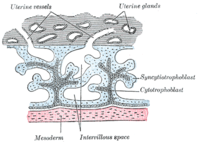
Photo from wikipedia
During formation of the mammalian placenta, trophoblasts invade the maternal decidua and remodel spiral arteries to bring maternal blood into the placenta. This process, known as endovascular invasion, is thought… Click to show full abstract
During formation of the mammalian placenta, trophoblasts invade the maternal decidua and remodel spiral arteries to bring maternal blood into the placenta. This process, known as endovascular invasion, is thought to involve the adoption of functional characteristics of vascular endothelial cells (ECs) by trophoblasts. The genetic and molecular basis of endovascular invasion remains poorly defined, however, and whether trophoblasts utilize specialized endothelial proteins in an analogous manner to create vascular channels remains untested. Vascular endothelial (VE-)cadherin is a homotypic adhesion protein that is expressed selectively by ECs in which it enables formation of tight vessels and regulation of EC junctions. VE-cadherin is also expressed in invasive trophoblasts and is a prime candidate for a molecular mechanism of endovascular invasion by those cells. Here, we show that VE-cadherin is required for trophoblast migration and endovascular invasion into the maternal decidua in the mouse. VE-cadherin deficiency results in loss of spiral artery remodeling that leads to decreased flow of maternal blood into the placenta, fetal growth restriction, and death. These studies identify a non-endothelial role for VE-cadherin in trophoblasts during placental development and suggest that endothelial proteins may play functionally unique roles in trophoblasts that do not simply mimic those in ECs.
Journal Title: eLife
Year Published: 2022
Link to full text (if available)
Share on Social Media: Sign Up to like & get
recommendations!